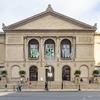More about The Herring Net
- All
- Info
- Shop

Contributor
Long fascinated by the simplicity of a rural coastal life, Winslow Homer visited several New England fishing towns during the summers of the 1870s.
In 1881-1882, he made a trip to the fishing town of Cullercoats in England. Witnessing the simplicity and hardship of life there changed his outlook and the nature of his artwork fundamentally, causing all his works after that date to focus on man’s tumultuous relationship with nature. In 1883, he moved to Prouts Neck, Maine, where this painting was conceived upon seeing a large harvest of herring. Homer’s work, which had been bright and vibrant before, took a darker and edgier turn when he began to concentrate on the lives of fishermen.
The fishermen of "Deadliest Catch" and the fisherman here rely and survive on a common thread: teamwork. One man hauls the catch, while another unloads the fish. Both have to keep balance against the stormy skies and temperamental waves. Even though the Alaskan fishermen have more tech and the Maine-landers here have only the little dory as their only means of travel, both pale to the whims of nature.
Charles W. Gould was the first owner of this piece after it left Homer’s hands. Gould is most known publicly for heading the relief efforts for Cubans fleeing from the devastation of the Spanish-American War at the behest of President William McKinley himself. The wealthy, dutiful board member and philanthropist was also the author of a book called "America: A Family Matter in 1922." Seems all hunky-dory by the title alone until you find out that the book actively called for the continuation of some pretty racist stuff: the maintenance of racial purity in America and the supremacy of the “white race” above all others. He might as well be wearing a white hood with eye holes cut out or a polo with a MAGA hat and a tiki torch.
Sources
- “Charles W. Gould.” n.d. Cooper Hewitt, Smithsonian Design Museum. Accessed February 1, 2019. https://collection.cooperhewitt.org/people/18050665/.
- “The Art Institute of Chicago.” n.d. Art Access: Rococo to Realist Art | The Art Institute of Chicago. Ryerson and Burnham Libraries. Accessed January 31, 2019. http://archive.artic.edu/american/herring-net/.
- “The Herring Net.” n.d. The Art Institute of Chicago. Arts of the Americas. Accessed February 1, 2019. https://www.artic.edu/artworks/25865/the-herring-net.















The Herring Net gives a dark and mysterious tone to the image with the dark clouds. I also like the subtle yet vibrant colors of the fish that pop out at you. This piece is so detailed and really gets the audience's attention!